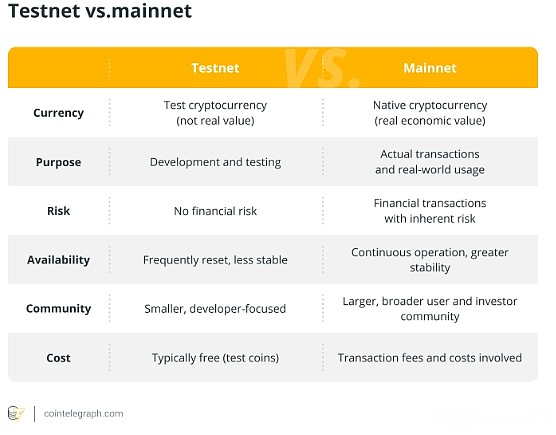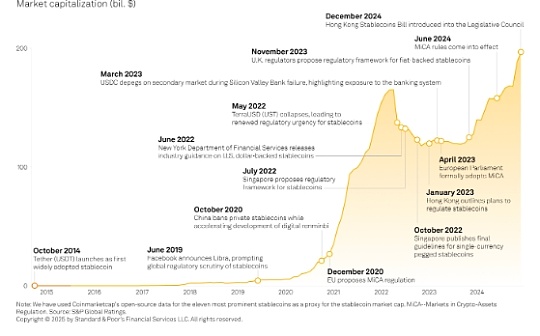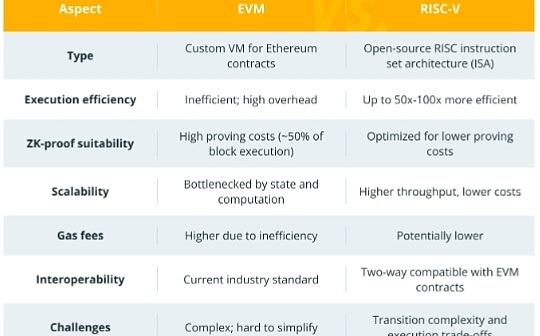
Author: Jagjit Singh, Cointelegraph; Compilation: Songxue, Bitchain Vision
1. Basic knowledge of main network
The main network is the abbreviation of “main network”, the main blockchain network where actual transactions occur, and transactions are carried out using native cryptocurrencies.
It is different from a testnet or experimental environment; rather, it is the product of development activities.The main network is characterized by using its own cryptocurrency, which is a digital asset necessary for network operation.This native currency is crucial to the governance procedures, staking plans and transaction fees of the ecosystem.
Blockchain platforms usually go through the testnet phase before they are launched on the main network.Developers can try these test environments without using actual cryptocurrencies.The platform is transferred to the main network, and transactions of actual assets can be carried out after deeming it is ready.The mainnet uses specific consensus processes to verify and confirm transactions, such as Proof of Work (PoW) or Proof of Stake (PoS).
Validators and miners are crucial on the mainnet, depending on the consensus mechanism.Proof of Work networks use complex mathematical puzzles that miners must solve in order to confirm transactions, add new blocks to the blockchain, and get paid in cryptocurrency.On the other hand, the proof-of-stake network relies on validators who choose to create blocks based on the amount of cryptocurrencies they hold and are willing to “collateralize” as collateral.
Depending on the blockchain network, the degree of decentralization varies, but it is a fundamental component of many mainnets.The improvement of decentralization requires more nodes to participate in the verification process.Due to the security and immutability of the mainnet, confirmed transactions will not be manipulated or changed.
The mainnet often supports decentralized applications (DApps) and smart contracts, thus extending the functionality of the network.The mainnet may be upgraded regularly to improve functionality or handle security issues, which can sometimes lead to forking.The fork can be a soft fork (a backward compatible change) or a hard fork (a non-backward compatible).
Cryptocurrency wallets allow users to communicate with the main network and send and receive transactions more efficiently.Because they provide consumers with accessibility and liquidity, exchanges are crucial to the ability to trade native tokens on the mainnet.
2. How does the main network work?
The mainnet of the blockchain platform consists of several important parts that work together to allow the network to run and process transactions and maintain the integrity of the distributed ledger.
The basic elements of the main network are as follows:
Blockchain AssociationDiscussion
Specific blockchain protocols power the mainnet, establishing guidelines and processes for verifying transactions and attaching them to the blockchain.Examples of blockchain protocols include Ethereum (using the Ethereum protocol) and Bitcoin (using the Bitcoin protocol).
Native cryptocurrency
Each mainnet contains a native cryptocurrency for different network functions.This includes paying transaction fees, rewarding validators (miners or stakeholders), and participating in governance processes.For example, Ethereum (ETH) on the Ethereum mainnet and Bitcoin (BTC) on the Bitcoin mainnet.
Consensus mechanism
The method or technology used by the network to reach consensus on the current state of the blockchain is called a consensus mechanism.PoW, PoS, commissioned proof of stake and other similar programs are common consensus techniques.The system prevents double spending and ensures the effectiveness of transactions.
Miner or Verifier
As mentioned earlier, miners solve complex mathematical puzzles in PoW networks, and validators in PoS networks are chosen based on the number of cryptocurrencies they own and are ready to stake.
Decentralized nodes
A single computer or server that retains an entire blockchain copy to participate in the network is called a node.These nodes talk to each other to agree on the current state of the blockchain.A large number of decentralized nodes enhance the decentralization and security of the network.
Smart contracts
A smart contract is an automatically executed contract, and the protocol conditions are clearly encoded.A large number of main networks support smart contracts.Smart contracts can be automatically executed and forced to fulfill contractual obligations without intermediaries.
Decentralized applications
DApp is a blockchain-based program that uses smart contracts to provide decentralized functions and services.They often interact with native tokens and add the overall functionality of the mainnet.
wallet
Wallets are essential to protect and access cryptocurrency assets.Users interact with the mainnet through a cryptocurrency wallet, which stores their private keys and enables them to send, receive and manage their digital assets.
comminicate
Cryptocurrency exchanges facilitate the transaction of native cryptocurrencies on the main network.The ability of users to purchase, sell and exchange digital assets gives market liquidity.
Governance mechanism
On some mainnets, participants can make suggestions and vote on major issues such as agreement modifications.These approaches promote decentralized governance and strengthen the democratic and community-driven characteristics of blockchain networks.
The importance of mainnet to users and developers
The mainnet provides users with real transactions and secure asset processing, while providing developers with innovative playgrounds such as DApps and smart contracts.
In the blockchain ecosystem, the main network is crucial to developers and users.Users see the main network as an active real-world environment where actual transactions occur, and they can use local currency for a variety of purposes.Users can be confident in the integrity of their digital assets because it guarantees the security and immutability of transactions.
Cryptocurrency wallets allow users to transmit, receive and manage their holdings while interacting with the main network.The main network cryptocurrency exchange provides users with a trading and liquidity access platform to improve the practicality of their assets.
The mainnet provides developers with an ideal environment for testing and deploying DApps and smart contracts.It means a shift from developing and testing in a closed environment (such as testing) to implementing innovation in the real world.Developers use the mainnet to demonstrate the practicality and functionality of their blockchain system.
In addition, the mainnet’s decentralized structure and consensus process provide a solid foundation for developing secure, open and difficult-to-penetrate applications.As a hub of user interaction and innovation, the main network has promoted the development and expansion of a larger blockchain ecosystem.
4. Test network and main network
The test network is a simulated environment for experimenting with cryptocurrencies, while the main network is a blockchain network that runs in real time.
During the blockchain development process, the test network and the main network have different functions.To provide a risk-free debugging and code optimization environment, the testnet is a mock environment that allows developers to test and experiment with new features or applications without using real cryptocurrencies.
On the other hand, the mainnet is an active blockchain network where real cryptocurrency transactions occur.It’s a real experience with all the risks and rewards of using a blockchain production version.

5. Mainnet deployment challenges faced by developers
Mainnet deployment challenges faced by blockchain developers include security, scalability, interoperability, compliance and governance, requiring meticulous code review, network architecture design and regulatory compliance to ensure seamless and user-orientedThe central blockchain experience.
One of the biggest obstacles for blockchain developers is mainnet deployment.There are challenges in developing and moving to the mainnet in a controlled, risk-free environment on the test network, which can have a real-world impact.
Another hurdle is ensuring that smart contracts and DApps are strong and secure enough to protect users and their assets.Since any error can lead to money loss or exploitation, developers must carefully review and test their code to find vulnerabilities.
Another key factor to consider when deploying a mainnet is scalability.
As user adoption increases, network capacity must be able to cope with the increase in transaction volume without sacrificing efficiency and speed.Balance between scalability and decentralization is a complex task that requires careful consideration of network architecture and consensus processes.
Another difficulty is related to interoperability.To promote a coherent blockchain ecosystem, developers must ensure smooth communication with other decentralized platforms, protocols and external systems.On the mainnet, managing regulatory compliance has also become more important, as developers must adhere to the ever-changing legislative framework that may vary across the globe.
Additionally, strategic planning and community engagement are necessary to manage network upgrades or hard forks without interfering with currently running services.To provide a smooth and user-friendly blockchain experience, developers must address security, scalability, interoperability, compliance, and governance issues in mainnet deployments.








